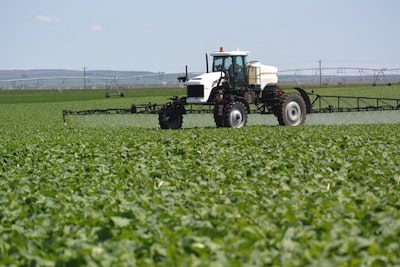Combining pest control operations to save trips over the field may seem like good economic sense, but consider the following when making this decision:
1. Is the tank mix supported by the product manufacturers? Before doing any tank mix, check the label to see if it’s approved or check with the manufacturers of all products proposed for the tank mix to make sure the mix is safe for the sprayer and operator, and that efficacy and plant health maintained for all products in the tank.
2. Be sure the insect or disease is present and apt to cause economic damage or yield loss. Applying an insecticide or fungicide while spraying for weeds does reduce application costs if you will need to spray fungicide or insecticide within the week anyway. But if you couldn’t justify spraying that product on its own, it doesn’t need to be added to the mix.
3. Un-needed sprays put beneficials at risk. Beneficial insects provide valuable natural control of many canola insect pests, including diamondback moth, lygus bug and bertha armyworm. Spraying these pests when economic thresholds predict it isn’t necessary puts heavy strain on beneficial populations.
4. Sustainability — of both our management tools and our farming system. This goes beyond just beneficials. Applying a pesticide routinely whenever a pest is present without considering economic thresholds can lead to resistance to those products, making them ineffective for when they are really needed to manage economic infestations. A core value for Canada’s canola industry is sustainability — a commitment to a profitable sustainable canola industry, including improving the health of consumers and our environment. Keep this core value of sustainability in mind when making spray decisions.
Test the mix
Before mixing herbicides with insecticides (or fungicides), make sure they are compatible. And if they are compatible, they may have strict rules for mixing order. Check labels for specific instructions. As the Guide to Crop Protection says, “If tank mixing is not done in the correct order, the result could be a tank-load of material that may not control the target pests, cause injury to the crop, plug nozzles, or leave an undesirable residue in the tank that will require extensive cleaning.” (See below for links to guides.)
The guide provides the following general rules for tank mixing, but it is a good idea to confirm this with product labels or a company representative:
- Fill the spray tank with 1/4 to 3/4 of the water required and turn on the agitation. Leave it on until the tank is emptied.
- Add any fertilizer or pH adjuster additives to the tank.
- Add any wettable powders, water dispersible granules or flowable liquid suspensions to the tank. Add dry products slowly to prevent clogged return lines. Allow sprayer to agitate for a few minutes before adding the next component.
- Shake any liquid containers thoroughly before adding to make sure they’re well mixed.
- Add any pesticides that are solutions (i.e. amines and salts)
- Add emulsifiable concentrates (i.e. esters)
- Add any surfactants or other adjuvants.
Use registered rates with tank mixes. Putting a cut rate of pesticide into a tank mix may do more harm than good. You may kill the weak population and select for the strong population, accelerating development of resistance to the chemical.

